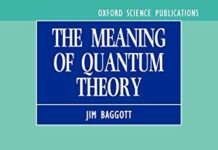
Ebook Info
- Published: 2012
- Number of pages: 300 pages
- Format: PDF
- File Size: 3.28 MB
- Authors: Jim Baggott
Description
The hunt for the Higgs particle has involved the biggest, most expensive experiment ever. So exactly what is this particle? Why does it matter so much? What does it tell us about the Universe? Did the discovery announced on 4 July 2012 finish the search? And was finding it really worth all the effort?The short answer is yes. The Higgs field is proposed as the way in which particles gain mass – a fundamental property of matter. It’s the strongest indicator yet that the Standard Model of physics really does reflect the basic building blocks of our Universe. Little wonder the hunt and discovery of this new particle produced such intense media interest.Here, Jim Baggott explains the science behind the discovery, looking at how the concept of a Higgs field was invented, how the vast experiment was carried out, and its implications on our understanding of all mass in the Universe.
User’s Reviews
Reviews from Amazon users which were colected at the time this book was published on the website:
⭐Science writer Jim Baggot was very fast to publish Higgs- which as pointed out by Steven Weinberg in the foreward means this book was largely written in anticipation of the discovery of the Higgs boson. Higgs is a an account of modern particle physics and its history. It goes through the evolution of theory and then the experimental physics which verified it. It does so in good detail, leaving out the math and describing how the zoo of particles was enlarged paper by paper.The book is split into two parts called Invention and Discovery. In Invention the author really starts at the beginning with the mathematical idea that facilitated much of modern physics which was Noether’s Theorem. The author then goes through Yang-Mils theory and then through the work of Murray Gell-Mann and the unification of the weak force with electro-magnetism. The author then describes how quarks were first pondered and then the Higgs field as well as how the Higgs field might “create” mass. The author ends the section with the work of Hooft and how he is able to deal with the math and make it coherent. In discovery the author then discusses the first particle accelerators and how the zoo of theoretical particles was slowly observed. it discusses the politics that were involved in the late 80s and early 90s which allowed the US to lose support whereas the Large Hadron Collidor continued on to be completed. The author then focuses on the LHC and takes us right up to current events where the higgs boson is confirmed to have been observed.This book is clear and informative. It discusses how we got here in both theory and practice and how much is unknown. All we know now is that there is a particle who has properties that are in line with what we would expect if there is a higgs field and though this is a remarkable fact, scientists know they have much more to do and much more to discover to be confident they have the right underlying structure. One always gets a bit lost in the zoo of particles that modern physics predicts exist and this book is no exception but the writing is clear and much is communicated well enough for the reader to be able to take out many ideas and facts
⭐*A full executive summary of this book is available at newbooksinbrief dot com.The main argument: Up until very recently, news out of the European Organization for Nuclear Research (CERN) regarding the progress of the new Large Hadron Collider (LHC) had been slow in coming, and nary a major discovery had been announced. On July 4th, though, all of that changed. As on that day CERN announced the discovery of nothing less than the Higgs boson, the ‘God particle’.The potential discovery of the Higgs boson had been one of the principal reasons why physicists were so excited about the LHC; and therefore, within the scientific community the announcement was cause for a major celebration indeed. For most of the general public, however, while the announcement was certainly intriguing, there were many basic questions yet to be answered: Just what was the Higgs boson, and why had it been labeled the God particle? Why were physicists expecting to find it, and what did the discovery really mean? Adequately answering these questions was more than what journalists were able to do in their compressed news segments and newspaper articles–and, besides this, it was a task that many journalists were not up to regardless.Jim Baggott’s new book ‘Higgs: The Invention and Discovery of the ‘God Particle” is meant to remedy this situation and provide the necessary context that the general public needs in order to understand the discovery of the Higgs boson and what it all means.With impressive clarity, Baggott first takes us through the history of the development of the Standard Model of particle physics (which theory the Higgs boson is a part). He begins with the discovery that atoms are made up of the still more elementary particles of electrons, protons and neutrons. And then takes us through the discovery of the still more fundamental particles of quarks, leptons and bosons, and the 4 fundamental forces that govern these particles: gravity, the electromagnetic force, the weak nuclear force, and the strong nuclear force.At every step of the way, Baggott is sure to explain what difficulties confronted the understanding of particle physics that was current at the time, what theoretical models were developed to overcome these difficulties, and the empirical evidence that was used to establish which theoretical model won the day. For instance, and of crucial importance here, is that–after learning of the 3 types of elementary particles, and the 4 basic forces–we learn that there was a problem with the then-current theory regarding the masses of the elementary particles–in that the 4 forces alone were simply unable to account for it. In order to overcome this difficulty, some physicists postulated that there must be a charged field pervading space, since such a field appeared to be the only appealing way to solve the mass mystery. This field was called the Higgs field.The problem was that there was as yet no empirical evidence that the Higgs field actually exists. What physicists did think, though, was that if it did exist, it would imply the existence of a certain type of boson particle, dubbed the Higgs boson. What this meant is that if physicists could find the Higgs boson, they would have empirical evidence that the Higgs field does in fact exist, and the problem regarding the masses of elementary particles would be adequately solved. On July 4th, it was the discovery of this very particle that was announced, and Baggott takes us behind the scenes at the LHC to explain just what went into the discovery.While the discovery of the Higgs boson solved one major problem with the Standard Model, there are a few others that have yet to be solved–including the hierarchy problem, and the problem of explaining gravity–and Baggott does touch on these issues as well.Amazing science, wonderfully told. A full executive summary of the book is available at newbooksinbrief dot com.
⭐As a layman with just a bit of technology training, much of this book is difficult for me. Having said that, the author does sprinkle in enough of the personal give and take among the scientists to permit me to appreciate this great journey of discovery. I was surprised that it did hold my interest.I recall a NOVA program years ago on PBS in which Richard Feynman said the quest to understand the universe is akin to seeking the rules of chess by observing only one square on a chess board. I now understand what Feynman was saying. These physicists are just groping about in the dark, trying to make sense of it all. Thanks to Baggott for taking me along on this great journey.I can recall in a freshman physics course in 1964 asking the professor for a definition of mass and being unsatisfied with his response. I now know that in 1964 nobody knew precisely what it was. We knew it was a measure of resistance to acceleration (F = m*a) but an explanation of what is mass seemed elusive at that time. The discovery of the Higgs boson, thus validating the Higgs mechanism, clears things up for me.
⭐This is a very interesting book about finding the bosun particle and not necessary about Higgs himself as I thought it would. Although a very interesting read about USA and Europe in a race to find the god particle. Thank goodness for Congress.Think there is a line in it that saysMeasurement was 39 billionth of a billionth of a second. You just shake your head at that.
⭐Rather above my head but interesting to realise how our scientists contact lijke minds across the world and exciting very exciting to see how they develop ideas and progress.
⭐Bought this great book its not for those who no nothing about the higgs ,but if you do then this book is worth the read.
⭐Excellent
⭐Das Buch war bei Ankunft neu und in bestem Zustand.Es ist ziemlich spannend, aber für jemanden der sich damit nicht auskennt und es nur aus Neugierde oder durch Empfehlung gekauft hat auch sehr verwirrend.Ich musste sehr viel nachgoogeln, aber es war trotzdem cool zum Lesen.P.S. Eines der Bücher wo die abgebildeten Bilder einfach echt nicht zum Verständnis beitragen
⭐
Keywords
Free Download Higgs: The invention and discovery of the ‘God Particle’ in PDF format
Higgs: The invention and discovery of the ‘God Particle’ PDF Free Download
Download Higgs: The invention and discovery of the ‘God Particle’ 2012 PDF Free
Higgs: The invention and discovery of the ‘God Particle’ 2012 PDF Free Download
Download Higgs: The invention and discovery of the ‘God Particle’ PDF
Free Download Ebook Higgs: The invention and discovery of the ‘God Particle’




